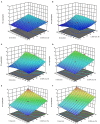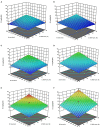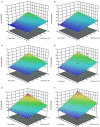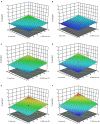Pulsed electric fields-assisted extraction of valuable compounds from red grape pomace: Process optimization using response surface methodology
- PMID: 37006934
- PMCID: PMC10063923
- DOI: 10.3389/fnut.2023.1158019
Pulsed electric fields-assisted extraction of valuable compounds from red grape pomace: Process optimization using response surface methodology
Abstract
Background: The application of Pulsed electric fields as a mild and easily scalable electrotechnology represents an effective approach to selectively intensify the extractability of bioactive compounds from grape pomace, one of the most abundant residues generated during the winemaking process.
Objective: This study addressed the optimization of the pulsed electric fields (PEF)-assisted extraction to enhance the extraction yields of bioactive compounds from red grape pomace using response surface methodology (RSM).
Methods: The cell disintegration index (Z p ) was identified as response variable to determine the optimal PEF processing conditions in terms of field strength (E = 0.5-5 kV/cm) and energy input (WT = 1-20 kJ/kg). For the solid-liquid extraction (SLE) process the effects of temperature (20-50°C), time (30-300min), and solvent concentration (0-50% ethanol in water) on total phenolic content (TPC), flavonoid content (FC), total anthocyanin content (TAC), tannin content (TC), and antioxidant activity (FRAP) of the extracts from untreated and PEF-treated plant tissues were assessed. The phenolic composition of the obtained extracts was determined via HPLC-PDA.
Results: Results demonstrated that the application of PEF at the optimal processing conditions (E = 4.6 kV/cm, WT = 20 kJ/kg) significantly enhanced the permeabilization degree of cell membrane of grape pomace tissues, thus intensifying the subsequent extractability of TPC (15%), FC (60%), TAC (23%), TC (42%), and FRAP values (31%) concerning the control extraction. HPLC-PDA analyses showed that, regardless of the application of PEF, the most abundant phenolic compounds were epicatechin, p-coumaric acid, and peonidin 3-O-glucoside, and no degradation of the specific compounds occurred upon PEF application.
Conclusion: The optimization of the PEF-assisted extraction process allowed to significantly enhance the extraction yields of high-value-added compounds from red grape pomace, supporting further investigations of this process at a larger scale.
Keywords: HPLC-PDA; bioactive compounds; green extraction; pulsed electric fields (PEF); red grape by-products; response surface methodology.
Copyright © 2023 Carpentieri, Ferrari and Pataro.
Conflict of interest statement
The authors declare that the research was conducted in the absence of any commercial or financial relationships that could be construed as a potential conflict of interest.
Figures








Similar articles
-
Sustainable Valorization of Industrial Cherry Pomace: A Novel Cascade Approach Using Pulsed Electric Fields and Ultrasound Assisted-Extraction.Foods. 2024 Mar 28;13(7):1043. doi: 10.3390/foods13071043. Foods. 2024. PMID: 38611349 Free PMC article.
-
Pulsed Electric Field-Assisted Extraction of Aroma and Bioactive Compounds From Aromatic Plants and Food By-Products.Front Nutr. 2022 Jan 27;8:792203. doi: 10.3389/fnut.2021.792203. eCollection 2021. Front Nutr. 2022. PMID: 35155517 Free PMC article.
-
Green Extraction Methods for Extraction of Polyphenolic Compounds from Blueberry Pomace.Foods. 2020 Oct 23;9(11):1521. doi: 10.3390/foods9111521. Foods. 2020. PMID: 33113955 Free PMC article.
-
The Potential of Grape Pomace Varieties as a Dietary Source of Pectic Substances.Foods. 2021 Apr 15;10(4):867. doi: 10.3390/foods10040867. Foods. 2021. PMID: 33921097 Free PMC article. Review.
-
A review of the polyphenols extraction from apple pomace: novel technologies and techniques of cell disintegration.Crit Rev Food Sci Nutr. 2023;63(29):9752-9765. doi: 10.1080/10408398.2022.2071203. Epub 2022 May 6. Crit Rev Food Sci Nutr. 2023. PMID: 35522079 Review.
Cited by
-
Comparison of different green extraction methods used for the extraction of anthocyanin from red onion skin.Food Sci Nutr. 2024 Jul 21;12(10):7347-7357. doi: 10.1002/fsn3.4354. eCollection 2024 Oct. Food Sci Nutr. 2024. PMID: 39479718 Free PMC article.
-
Valorization of Grape Pomace: A Review of Phenolic Composition, Bioactivity, and Therapeutic Potential.Antioxidants (Basel). 2024 Sep 19;13(9):1131. doi: 10.3390/antiox13091131. Antioxidants (Basel). 2024. PMID: 39334790 Free PMC article. Review.
-
Improving Olive Leaf Phenolic Extraction with Pulsed Electric Field Technology Pre-Treatment.Foods. 2025 Jan 23;14(3):368. doi: 10.3390/foods14030368. Foods. 2025. PMID: 39941961 Free PMC article.
-
A Comprehensive Review of Phenolic Compounds in Horticultural Plants.Int J Mol Sci. 2025 Jun 16;26(12):5767. doi: 10.3390/ijms26125767. Int J Mol Sci. 2025. PMID: 40565226 Free PMC article. Review.
-
Antioxidant and Anti-Inflammatory Effects of Extracts from Pulsed Electric Field-Treated Artichoke By-Products in Lipopolysaccharide-Stimulated Human THP-1 Macrophages.Foods. 2022 Jul 28;11(15):2250. doi: 10.3390/foods11152250. Foods. 2022. PMID: 35954020 Free PMC article.
References
-
- Pataro G, Carullo D, Ferrari G. Innovative processes for the extraction of bioactive compounds from winery wastes and by-products. Imp Sust Viticult Winemaking Prac. (2022) 1:281–303. 10.1016/B978-0-323-85150-3.00004-9 - DOI
-
- Gubitosa J, Rizzi V, Laurenzana A, Scavone F, Frediani E, Fibbi G, et al. . The “end life” of the grape pomace waste become the new beginning: the development of a virtuous cycle for the green synthesis of gold nanoparticles and removal of emerging contaminants from water. Antioxidants. (2022) 11:994. 10.3390/antiox11050994 - DOI - PMC - PubMed
LinkOut - more resources
Full Text Sources
Miscellaneous

